

Pearltrees. Pearltrees refers to itself as "a place for your interests".[8] Functionally the product is a visual and collaborative curation tool[9][10][11][12] that allows users to organize, explore and share any URL they find online as well as to upload personal photos, files and notes.[13] The product features a unique visual interface[14][15] that allows users to drag and organize collected URLs, and other digital objects.[16] that themselves can be further organized into collections and sub-collections,[17] (URLs).

Users of the product can also engage in social/collaborative curation using a feature called Pearltrees Teams.[18] Pearltrees was founded by Patrice Lamothe, CEO,[22] Alain Cohen, CTO,[23] Nicolas Cynober, Technical Director,[24] Samuel Tissier, Ergonomy/UI[25] and Francois Rocaboy, CMO.[26] History[edit] Popplet. Skype. Skype /ˈskaɪp/ is a freemium voice-over-IP service and instant messaging client, currently developed by the Microsoft Skype Division.
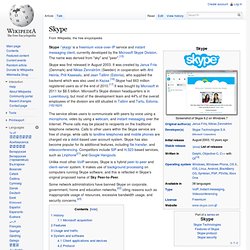
The name was derived from "sky" and "peer".[15] Skype was first released in August 2003. It was created by Janus Friis (Denmark) and Niklas Zennström (Sweden) in cooperation with Ahti Heinla, Priit Kasesalu, and Jaan Tallinn (Estonia), who supplied the backend which was also used in Kazaa.[16] Skype had 663 million registered users as of the end of 2010.[17] It was bought by Microsoft in 2011 for $8.5 billion. Microsoft's Skype division headquarters is in Luxembourg, but most of the development team and 44% of the overall employees of the division are still situated in Tallinn and Tartu, Estonia.[18][19][20] The service allows users to communicate with peers by voice using a microphone, video by using a webcam, and instant messaging over the Internet. Collaborative real-time editor. A collaborative editor is a form of collaborative software application that allows several people to edit a computer file using different computers, a practice called collaborative editing.
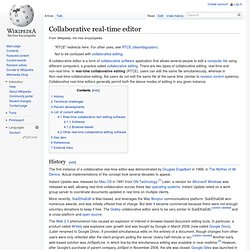
There are two types of collaborative editing: real-time and non-real-time. In real-time collaborative editing (RTCE), users can edit the same file simultaneously, whereas in Non-real-time collaborative editing, the users do not edit the same file at the same time (similar to revision control systems). Collaborative real-time editors generally permit both the above modes of editing in any given instance. History[edit] PiratePad.
Google Docs. An example of a document in Google Docs Google Docs is a free, web-based office suite offered by Google within its Google Drive service. It was formerly a storage service as well, but has since been replaced by Google Drive.[3] It allows users to create and edit documents online while collaborating with other users live.
Google Docs combines the features of Writely and Spreadsheets with a presentation program incorporating technology designed by Tonic Systems. Data storage of files was introduced on January 12, 2010 with 1 GB of free space. Google Drive. Google Drive is a file storage and synchronization service provided by Google, released on April 24, 2012,[4][5] which enables user cloud storage, file sharing and collaborative editing.
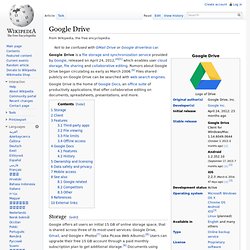
Rumors about Google Drive began circulating as early as March 2006.[6] Files shared publicly on Google Drive can be searched with web search engines. Google Drive is the home of Google Docs, an office suite of productivity applications, that offer collaborative editing on documents, spreadsheets, presentations, and more. Storage[edit] Google offers all users an initial 15 GB of online storage space, that is shared across three of its most-used services: Google Drive, Gmail, and Google+ Photos[7] (aka Picasa Web Albums).[8] Users can upgrade their free 15 GB account through a paid monthly subscription plan to get additional storage.[8] Documents using Google Docs native formats (including .gdoc, .gslides, and .gsheet) do not count towards this quota. Getting Things Done. The GTD method rests on the idea of moving planned tasks and projects out of the mind by recording them externally and then breaking them into actionable work items.
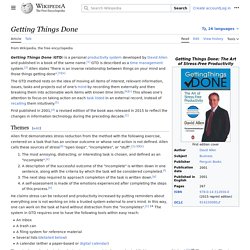
This allows attention to be focused on taking action on tasks, instead of recalling them.[2] First published in 2001, a revised edition of the book was released in 2015 to reflect the changes in information technology during the preceding decade. Themes[edit] Allen first demonstrates stress reduction from the method with the following exercise, centered on a task that has an unclear outcome or whose next action is not defined. Allen calls these sources of stress "open loops", "incompletes", or "stuff".[1]:13 He claims stress can be reduced and productivity increased by putting reminders about everything you are not working on into a trusted system external to your mind. Workflow[edit] Logic tree diagram illustrating the second and third steps (process/clarify and organize) of the five-step Getting Things Done workflow. Nirvana - GTD Software for Getting Things Done - Web, Mobile, Online, Everywhere.
SlideShare. The website gets an estimated 58 million unique visitors a month,[7] and has about 16 million registered users.
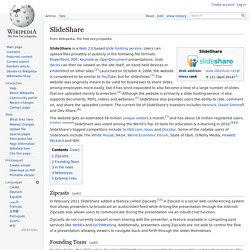
[citation needed] SlideShare was voted among the World's Top 10 tools for education & e-learning in 2010.[8][9] SlideShare's biggest competitors include Scribd.com, Issuu and Docstoc. Some of the notable users of SlideShare include The White House, NASA, World Economic Forum, State of Utah, O'Reilly Media, Hewlett Packard and IBM. §Zipcasts[edit] In February 2011 SlideShare added a feature called Zipcasts.[10] A Zipcast is a social web conferencing system that allows presenters to broadcast an audio/video feed while driving the presentation through the Internet.
Zipcasts also allows users to communicate during the presentation via an inbuilt chat function. Zipcasts do not currently support screen sharing with the presenter, a feature available in competing paid services like WebEx and GoToMeeting. Prezi. Prezi is a cloud-based (SaaS) presentation software and storytelling tool for presenting ideas on a virtual canvas.[1][2][3][4][5] The product employs a zooming user interface (ZUI), which allows users to zoom in and out of their presentation media, and allows users to display and navigate through information within a 2.5D or parallax 3D space on the Z-axis.
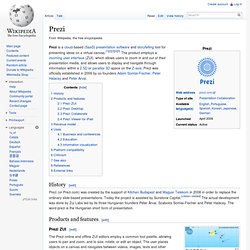
Prezi was officially established in 2009 by co-founders Adam Somlai-Fischer, Peter Halacsy and Peter Arvai. History[edit] Prezi (or Prezi.com) was created by the support of Kitchen Budapest and Magyar Telekom in 2008 in order to replace the ordinary slide based presentations. Today the project is assisted by Sunstone Capital. YouTube. Twitter. History Creation and initial reaction Twitter's origins lie in a "daylong brainstorming session" held by board members of the podcasting company Odeo.
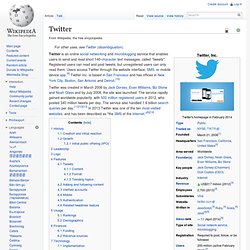
Dorsey, then an undergraduate student at New York University, introduced the idea of an individual using an SMS service to communicate with a small group.[15][16] The original project code name for the service was twttr, an idea that Williams later ascribed to Noah Glass,[17] inspired by Flickr and the five-character length of American SMS short codes.
The developers initially considered "10958" as a short code, but later changed it to "40404" for "ease of use and memorability. ...we came across the word 'twitter', and it was just perfect. LinkedIn. LinkedIn /ˌlɪŋkt.ˈɪn/ is a business-oriented social networking service.
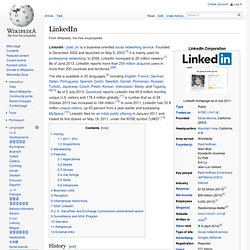
Why I Connect With Strangers on LinkedIn. In online and real-world networking, the same principle applies: You never know when you might make a crucial connection.
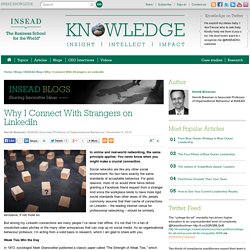
Social networks are like any other social environment: No two have exactly the same standards of acceptable behaviour. For good reasons, most of us would think twice before granting a Facebook friend request from a stranger. And since the workplace tends to have more rigid social standards than other areas of life, people commonly assume that their cache of connections on LinkedIn – the leading internet venue for professional networking – should be similarly exclusive, if not more so. Facebook. This article is about the social networking service. For the type of directory, see face book. Facebook (formerly [thefacebook]) is an online social networking service headquartered in Menlo Park, California. Facebook was founded on February 4, 2004, by Mark Zuckerberg with his college roommates and fellow Harvard University students Eduardo Saverin, Andrew McCollum, Dustin Moskovitz and Chris Hughes.[7] The founders had initially limited the website's membership to Harvard students, but later expanded it to colleges in the Boston area, the Ivy League, and Stanford University.
TED (conference) TED (Technology, Entertainment, Design) is a global set of conferences owned by the private non-profit Sapling Foundation, under the slogan "ideas worth spreading". TED was founded in 1984 as a one-off event.[1] The annual conference began in 1990, in Monterey, California.[4] TED's early emphasis was technology and design, consistent with its origins in the Silicon Valley. Since June 2006,[1] the talks have been offered for free viewing online, under Attribution-NonCommercial-NoDerivs Creative Commons license, through TED.com.[8] As of April 2014, over 1,700 talks are available free online.[9] By January 2009 they had been viewed 50 million times.
In June 2011, the viewing figure stood at more than 500 million,[10] and on Tuesday, November 13, 2012, TED Talks had been watched one billion times worldwide.[11] TED's mission statement begins: We believe passionately in the power of ideas to change attitudes, lives and ultimately, the world.